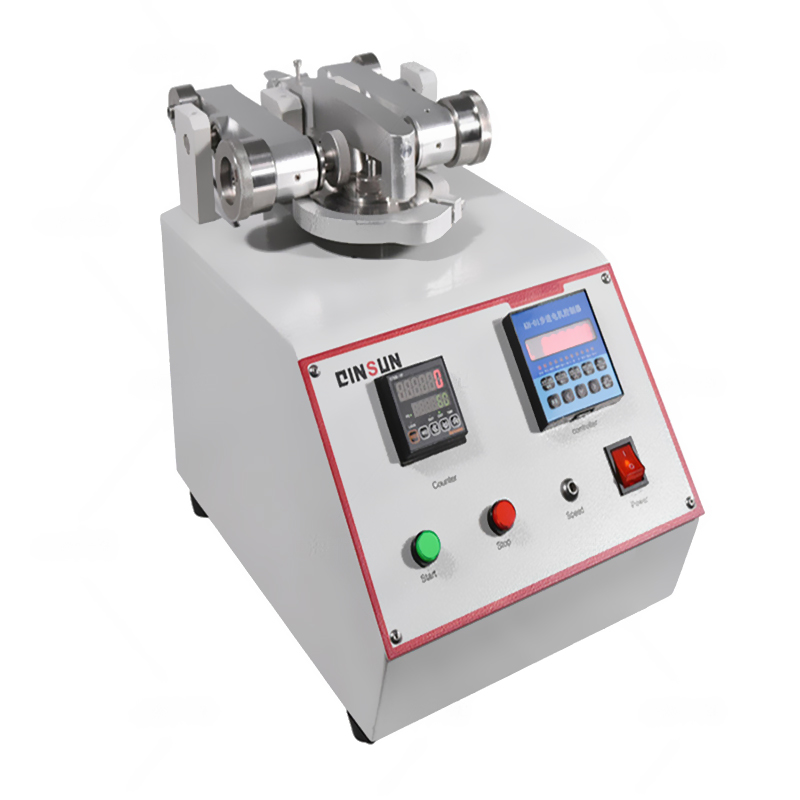
Rotating wear-resistant tester features
2024/04/16
Technical advantages:
1. LCD touch screen;
2. The loading and unloading of the grinding wheel is simple and fast, and the replacement of key components is easy;
3. 50000 revolutions per measurement test;
4. Adjustable speed of 60 or 72rpm;
5. Durable and sturdy testing arm components;
6. Newly designed support frame and shell, DC vacuum nozzle, adjustable height;
7. Intermittent automatic shutdown can be set during the testing process;
8. Store test configuration files;
9. Can replace 8mm and 11mm screw in vacuum nozzles;
10. Optional display options (including Chinese menus).
Compliant with standards:
ASTM D3884, ASTM D1175, ASTM D1044, ASTM D4060, TAPPI T476, ISO 9352, ISO 5470-1, JIS K7204, JIS A1453, JIS K6902, JIS L1096, JIS K6964, DIN 52347, DIN 53109, DIN 53754, DIN 53799, etc.
The Taber test quickly provides reliable test data for evaluating the wear resistance of materials. A flat sample is installed on a sample stage that rotates vertically. During the rotation of the sample stage, friction and wear occur when the sample contacts two sliding wear wheels. At the same time, a vacuum system sucks away the waste generated during the testing process. The pattern generated by friction is a circular ring composed of intersecting arcs, with an area of about 30 square centimeters.
Main features:
Testing principle science: The Taber wear tester adopts the principle of friction, which can simulate the friction and wear of materials in actual use, thereby obtaining more realistic and reliable wear resistance data.
Widely applicable: Taber wear-resistant tester is suitable for various materials, such as cloth, paper, paint, plywood, leather, floor tiles, glass, natural rubber, artificial flooring, etc.
High degree of automation: The Taber wear tester adopts advanced electronic technology, which can automatically record and display wear resistance data, and also automatically control the testing process.
High precision: The Taber wear tester adopts a high-precision measurement system and sensors, which can accurately measure the wear and friction parameters of materials, ensuring the accuracy and reliability of test results.
Easy to operate: The Taber wear-resistant tester is easy and convenient to operate, taking only a few minutes to complete the test, and does not require professional technical personnel.

Usage:
Preparation of specimens: Select an appropriate amount of specimens and stick them onto the specified specimens.
Install the grinding wheel: Install the grinding wheel marked with LIGHT WHIEL on the right side, and the grinding wheel marked with LIGHT WHIEL on the left side, with the label facing outward. When the grinding wheel wears to the outer edge of the label, it should be replaced immediately.
Place the specimen: Place the specimen on the test plate, taking care not to let it come into contact with the grinding wheel.
Adjusting the counterweight: Adjust the counterweight on both sides to ensure equal weight and accuracy of the test values.
Start test: Turn on the vacuum cleaner, press the switch, let the specimen rotate a certain number of turns at the specified speed, and then stop the machine.
Data recording: Record the weight and friction parameters of the specimen before and after testing, and calculate the wear resistance data of the material.
In summary, the Taber wear tester is a powerful, easy to operate, and reliable wear resistance testing equipment that can be widely used in the wear resistance testing of various materials.
Previous: Paper tensile strength tester standards
N e x t : Diaper impurity tester standards



